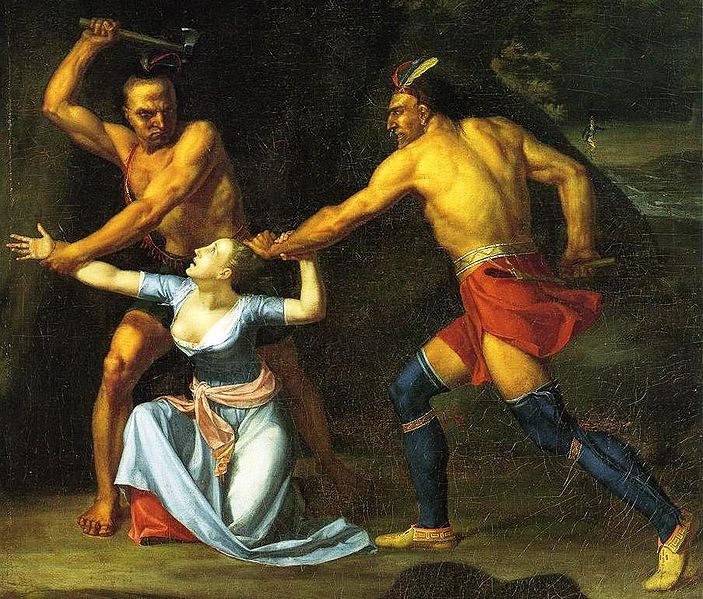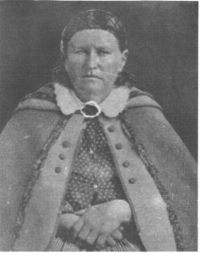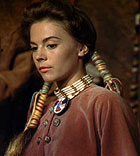|
|
Death of Jane McCrea (1804) |
|
Captivity Narrative |
Captivity narratives are a popular plot, narrative, or story-line in American (and world) literature. Stories of capture, suffering, rescue, and escape seem to appeal to primal human emotions and fit the ever-popular romance narrative.
In American literature, captivity narratives often relate particularly to the capture of European-American settlers or explorers by Native American Indians, but the captivity narrative is so inherently powerful that the story proves highly adaptable to new contents from terrorist kidnappings to UFO abductions.
Prototypes in world literature may be found in stories involving hostages such as The Tale of Genji (11c Japan) or captivities of English travelers or sailors by Barbary Pirates in the Mediterranean in the 1500s, and even by popular romances involving rescues of fair damsels from rogue knights, ogres, trolls, ethnic others.
In colonial North America this narrative originally told more-or-less factual stories of real people--sometimes women--captured by Indians; their trials, sufferings, adventures; finally, their escape, redemption, or death. Many of these narratives were published in New England and later in the west.
Nonfiction examples in early American literature:
Cabeza de Vaca, La Relacion concerning this Spanish explorer's captivity among Southwestern Indians.
John Smith's A General History of Virginia (1624) concerning his captivity by Powhatan & rescue by Pocahontas
Mary Rowlandson, Narrative of the Captivity and Restoration of Mrs. Mary Rowlandson (1682)
Significance:
![]() Anticipates popular fiction,
esp. romance narrative: action,
blood, suffering, redemption—a page-turner
Anticipates popular fiction,
esp. romance narrative: action,
blood, suffering, redemption—a page-turner
![]() Anticipates or
prefigures gothic literature with
depictions of Indian “other” as dark, hellish, cunning, unpredictable
Anticipates or
prefigures gothic literature with
depictions of Indian “other” as dark, hellish, cunning, unpredictable
![]() Association of Indians as “heathen” and
“hellish” connects the later gothic to its base in Judeo-Christian and
Neoplatonic aesthetics of light-dark, etc.
Association of Indians as “heathen” and
“hellish” connects the later gothic to its base in Judeo-Christian and
Neoplatonic aesthetics of light-dark, etc.
![]() Opportunity for a
woman’s writing and
experience
Opportunity for a
woman’s writing and
experience
![]() Interpretation of
American experience
as Christian or biblical allegory
Interpretation of
American experience
as Christian or biblical allegory
![]() For multicultural or cross-cultural studies, captivity
narratives often provide important data on non-literate societies
and show captives adapting to a cross-cultural identity between
that of his or her birth society and his or her captors.
For multicultural or cross-cultural studies, captivity
narratives often provide important data on non-literate societies
and show captives adapting to a cross-cultural identity between
that of his or her birth society and his or her captors.
As the genre became popular it grew more formulaic with standard scenes, and the factual became more fictional. Eventually the Captivity Narrative became a recurrent plot device in American literature and film.
-
William Faulkner, Sanctuary (1931) (Upper-class young woman held hostage by sadistic criminal)
Other novels with elements of captivity narrative:
-
Alexandre Dumas, The Count of Monte Cristo (1844)
-
The Tale of Genji (11c Japan)
films depicting Indian captivities
-
The Searchers, 1956 film directed by John Ford, starring John Wayne
-
Little Big Man (1970)
-
Dances with Wolves (d. Kevin Costner) (1990)
-
Black Robe (1991)
films / video with elements of captivity narrative
-
Vietnam POW / MIA films: The Deer Hunter (1978), Uncommon Valor (1983), Missing in Action (1984), Rambo II (1985)
-
Oldboy (2003): S. Korean film re man held 15 years in hotel room, released to take vengeance on conspiracy that imprisoned him. (cf. The Count of Monte Cristo)
-
Taken (2008): CIA agent's daughter kidnapped in France
-
Taken (2002): TV miniseries re extraterrestrial aliens following Roswell and other UFO incidents
Historical events associated with captivity narratives
-
19-year-old Patty Hearst, heiress to Hearst News Corporation, abducted by militant urban leftist Symbionese Liberation Army; joined bank robberies; arrested, imprisoned, later pardoned.
-
1967-73, future U.S. Senator, 2008 Republican Presidential Nominee, and Vietnam War U.S. Navy Pilot John McCain shot down and wounded over Hanoi, held and tortured as Prisoner of War
-
1979-81 Iranian Hostage Crisis: 52 Americans held hostage for 444 days in U.S. Embassy in Tehran by Iranian Revolutionary students and soldiers
-
During 2nd U.S. Iraqi War, March-April 2003, 20-year-old Private First Class Jessica Lynch of U.S. Army Quartermaster Corp wounded and captured in Iraqi forces ambush, rescued from Iraqi hospital by U.S. Special Forces.
-
Daniel Pearl (1963-2002), South Asia Bureau Chief of Wall Street Journal holding American & Israeli citizenship and based in Mumbai, India, kidnapped in Pakistan and beheaded by Al Qaeda in 2002. His wife Mariane (who delivered their son four months after his death) wrote A Mighty Heart (2003), which became a 2007 film starring Angelina Jolie.
Other cultural phenomena with captivity-rescue elements:
-
UFO abductions
-
Super Mario Bros. video games (Mario & Luigi rescue Princess Toadstool from Bowser)
Texas's most famous captivity narrative
Cynthia Parker / Naduah of Fort Parker & the Comanches
|
|
|
Texas's most famous captivity narrative is that of Cynthia Parker (1827-70) from a Scots-Irish settler family whose encampment at Old Fort Parker in Mexia was overrun by Comanche Indians in 1836. Nine-year-old Cynthia and other members of the Parker family were taken captive. She witnessed the torture of several family members.
Cynthia, renamed Naduah, later married Comanche Chief Peta Nocona, becoming mother of the great Comanche Chief Quanah Parker (1845-1911). In 1860 Cynthia Parker and her two-year-old daughter Prairie Flower were returned by Texas Rangers to the white settlements. Cynthia Parker tried to escape and return to the Comanches.
|
|
|
The classic 1956 captivity-narrative film The Searchers was partly based on the story of Cynthia Parker. The film remains controversial for representing the disdain and defensiveness early white settlers felt toward American Indians.
|
|
|
Significance of the Captivity Narrative
self-other: white self and Indian other
test of ethnic faith or loyalty: Will captive "go native," crossing to the other side, esp. by intermarriage?
(With male captives, risk seems less since he can abandon mixed-race children and relocate more easily back to white settlements.)
test of womanhood and womanly identity: if woman resorts to violence to escape, she may appear as a heroine to modern readers, but readers of the time may have found such actions threatening to traditional femininity and masculinity.
slave narrative as comparable companion to
captivity narrative

Abduction of Daniel Boone's Daughter by the Indians (1853)
by Karl
Ferdinand Wimar (1828-62)

Statue of Hannah Dustin
in Pennacook NH
(Dustin and her infant were
captured by Abenaki Indians in Haverill MA in 1697. Her infant was killed by
Indians. Later she and two companions escaped after killing and scalping ten
Indians, mostly women and children.)







